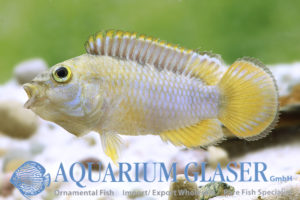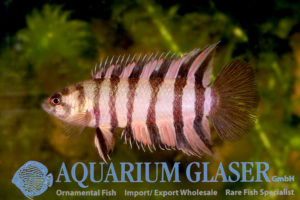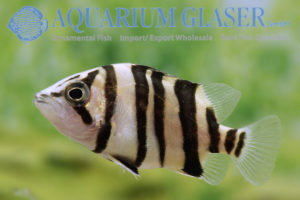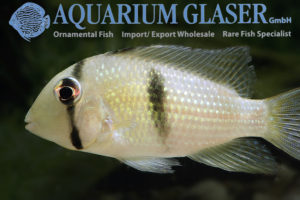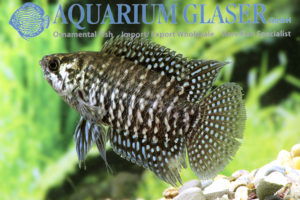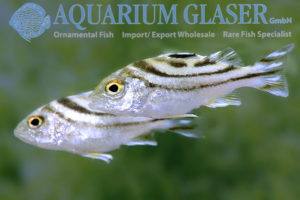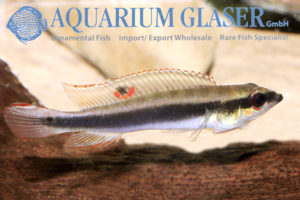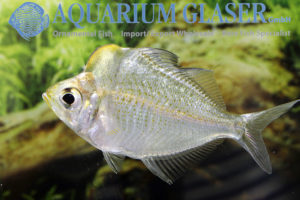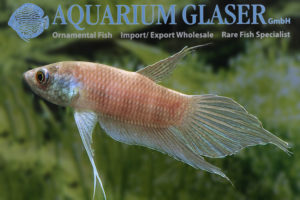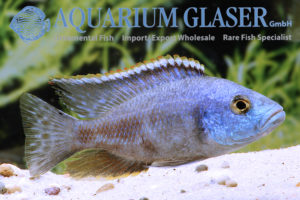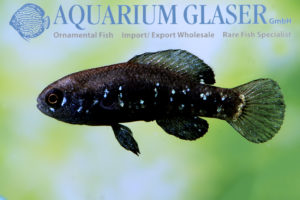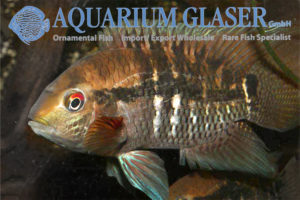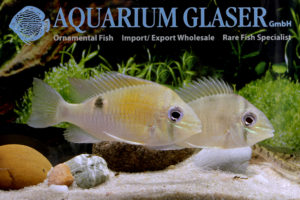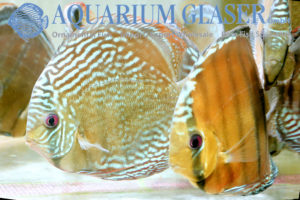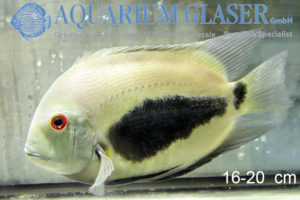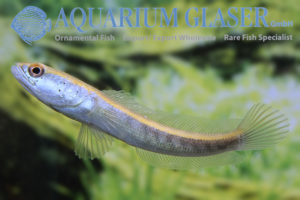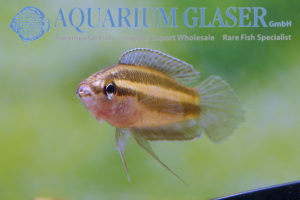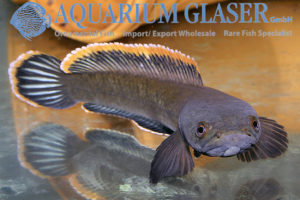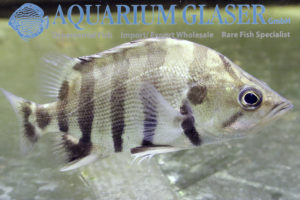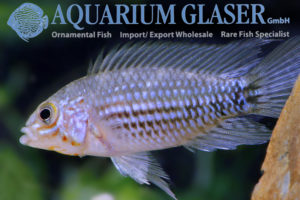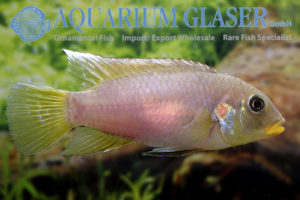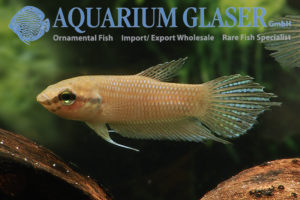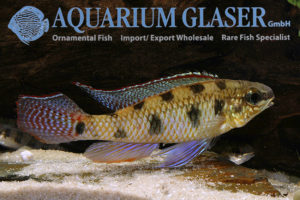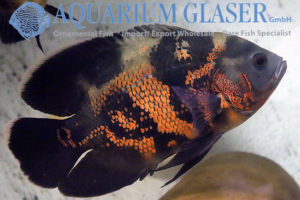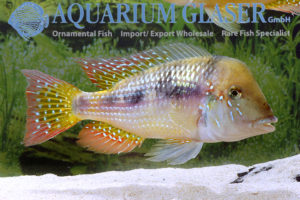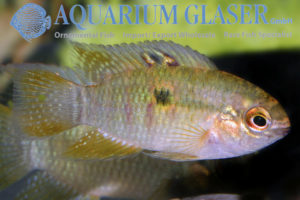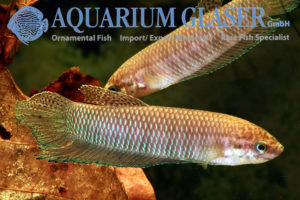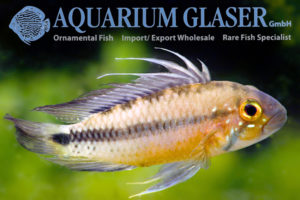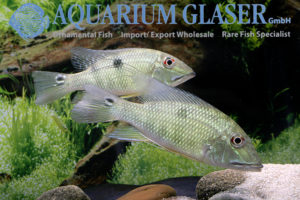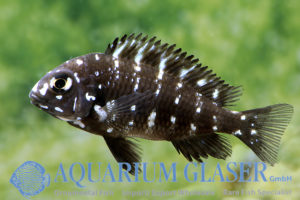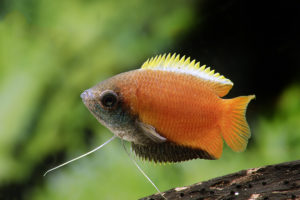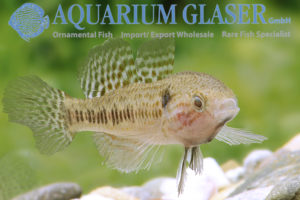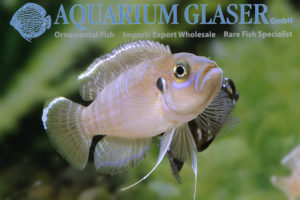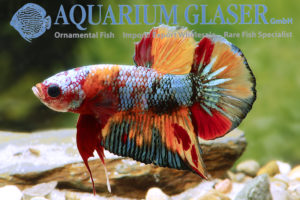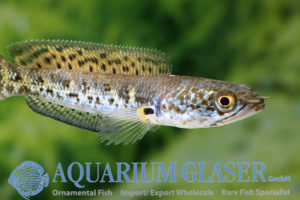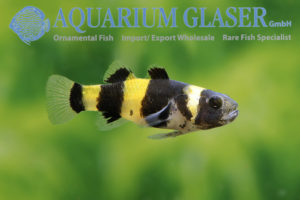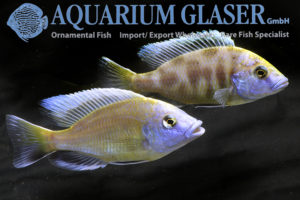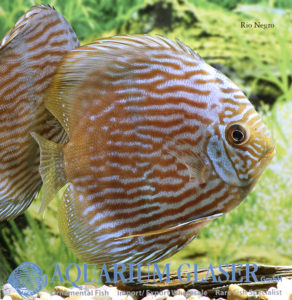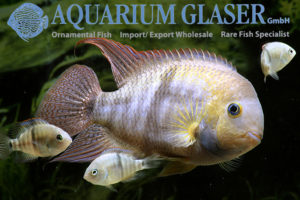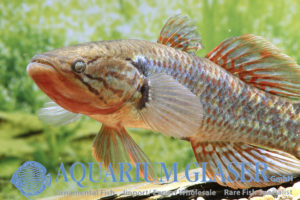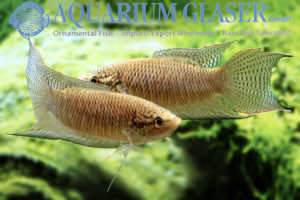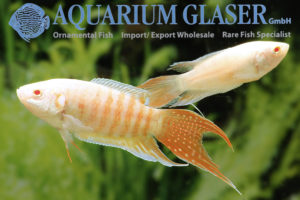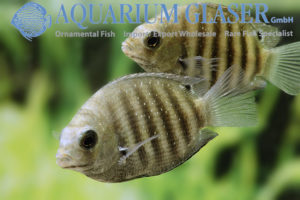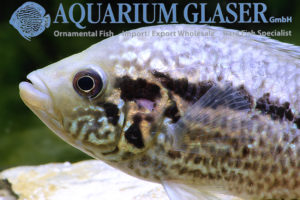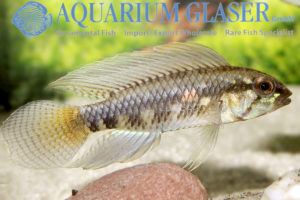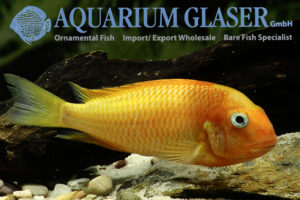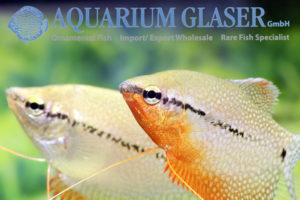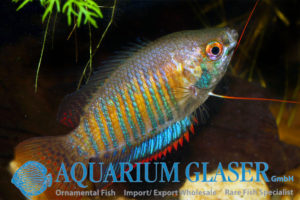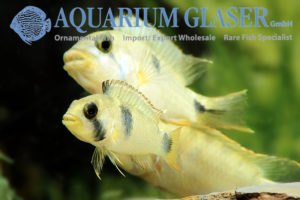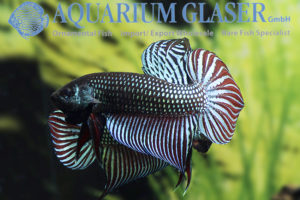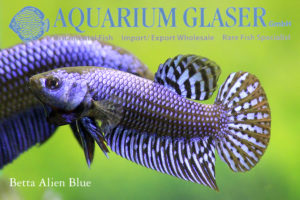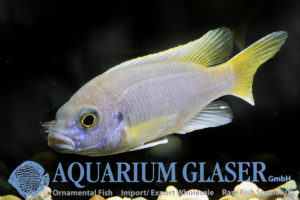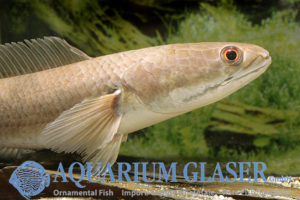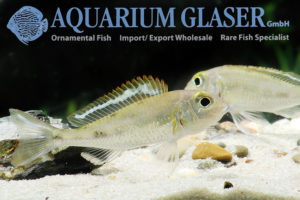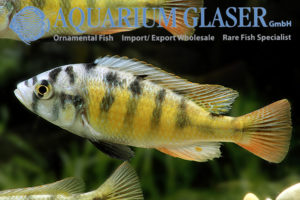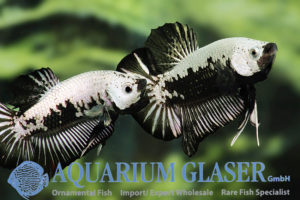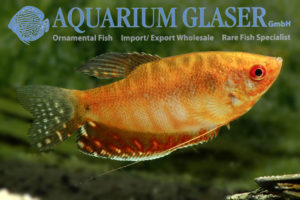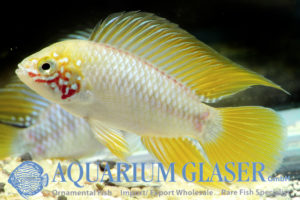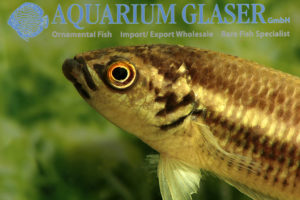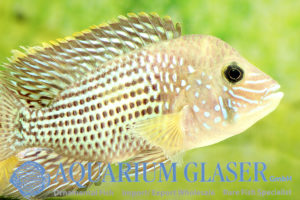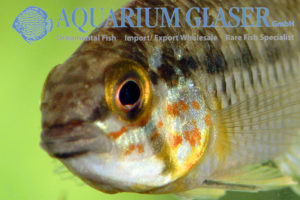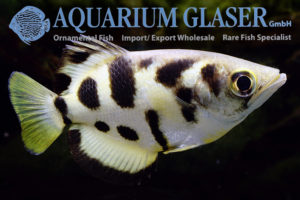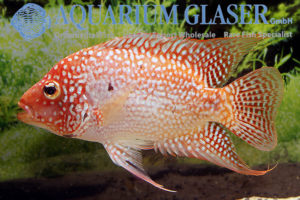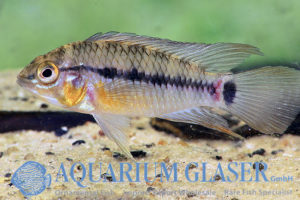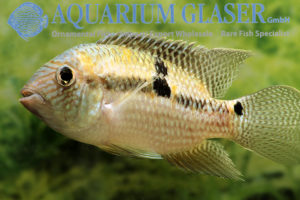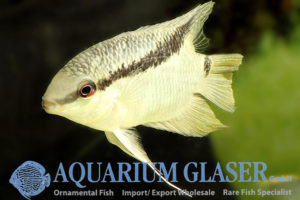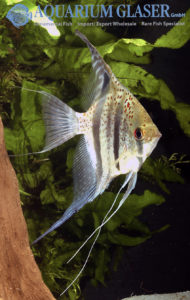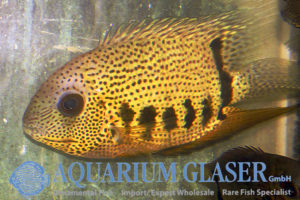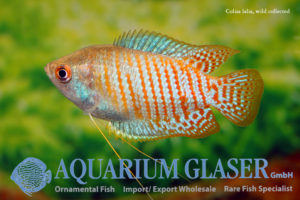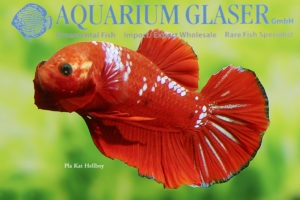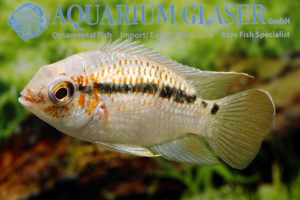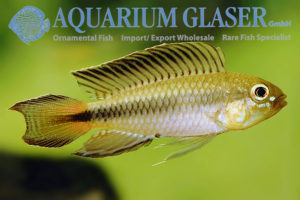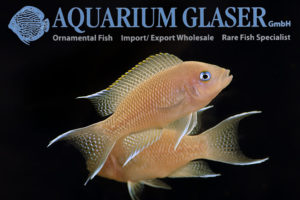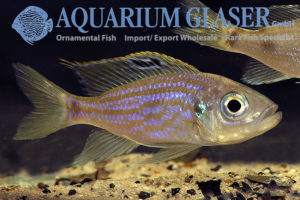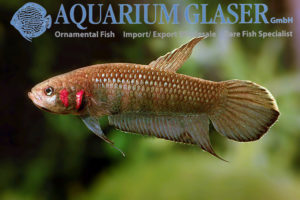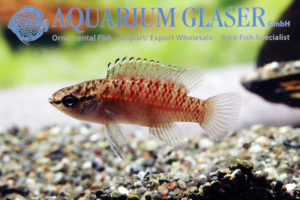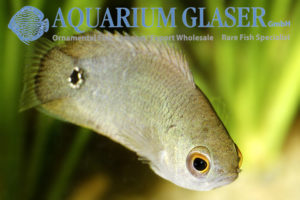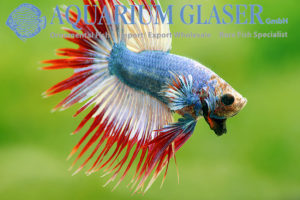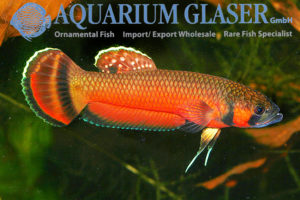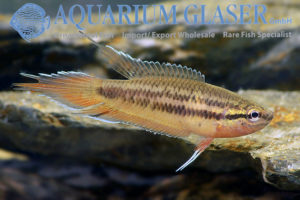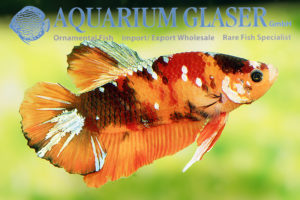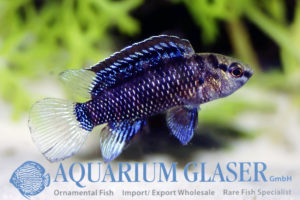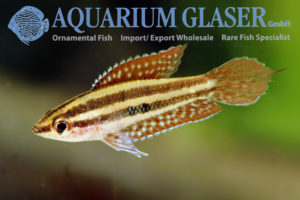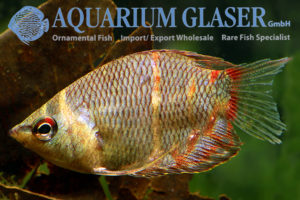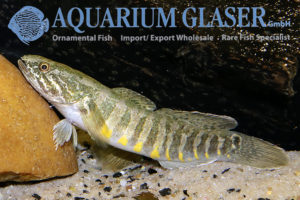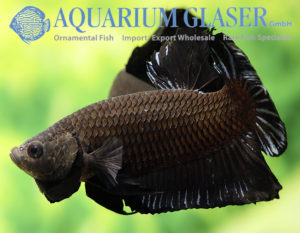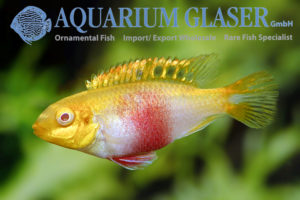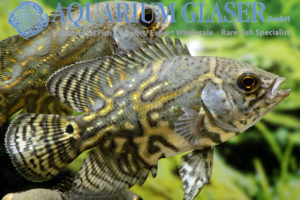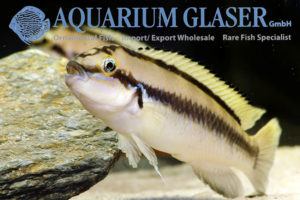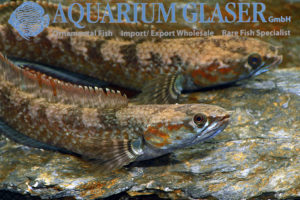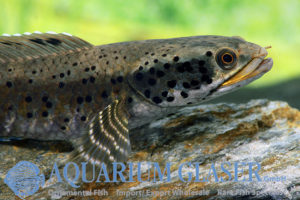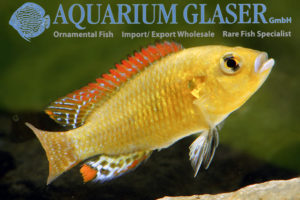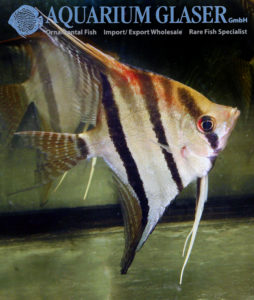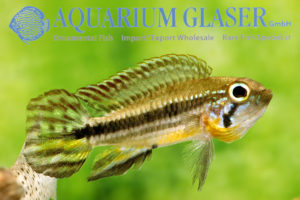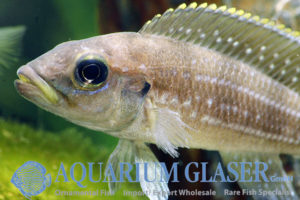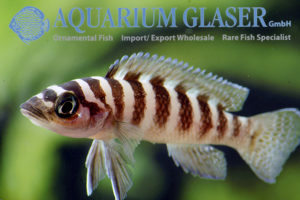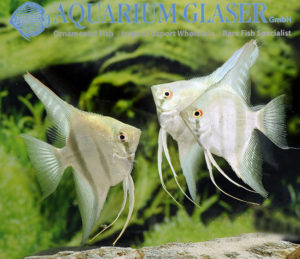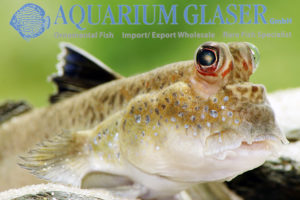The Panda Dwarf Cichlid (Apistogramma nijsseni) was an absolute sensation when it was first introduced at the end of the 1970s. The breeding was successful right away, but it took several years before it was understood that the – often extreme – male surplus observed in the offspring came from too high water temperatures during […]
25. Perchlike fishes (912)
-
-
Microctenopoma ansorgii
We have very nice and stable wild catches of the Orange Bushfish from the Congo in our stock. The bubblenest-building species grows to about 6-8 cm, currently the animals are 3-4 cm long. The Orange Bushfish is a very interesting species. It becomes already half grown and sexually mature. With increasing age the fish becomes […]
-
Datnioides microlepis
The Indonesian Tiger Fish (Datnioides microlepis) is without any doubt the most beautiful species of Tiger Perch. These large growing predators can reach a maximum length around 50 cm and are wonderful show fish for large aquaria. But the photographed fish are still young, 4-6 cm long. There are two populations of this perch, one […]
-
Guianacara dacrya
The genus Guianacara currently comprises seven described species, all of which originate from the Guiana shield in South America. The genus was only established in 1989 and only one species – G. geayi – was known before; Pellegrin described it in 1909. From this one can already conclude that the species look quite similar. Before […]
-
Microctenopoma fasciolatum
Within the African labyrinth fishes, the so-called bushfishes, one can roughly differentiate between two groups: those that do not care for their brood and those in which the males build a foam or bubble nest, into which they are spawned and which is guarded by the male until the young fish are independent. The latter […]
-
Terapon jarbua
This brackish water fish – adult Terapon jarbua usually live in the sea, juveniles in brackish water, but the species is euryhalin and can be found both in the sea and in freshwater – is widespread along the coasts of South East Asia to Australia and East Africa. From the Red Sea, T. jarbua has […]
-
Crenicichla sp. “regani-Orinoco”
The pike cichlids (Crenicichla) are one of the most species-rich cichlid genera with 94 valid species at present. Many species grow to well over 20 cm in length and thus belong to the large cichlids, but there are also dwarf cichlids. The latter include the beautiful, slender C. regani, which according to literature should grow […]
-
Parambassis pulcinella
Once more we were able to import the most peculiar species of glass perch: Parambassis pulcinella. This freshwater fish originates from clear streams in the border region between Thailand and Burma. The maximum size reported so far is about 10 cm. Against conspecifics the species is rather peaceful. They tend to tease each other sometimes […]
-
Betta raja
With 73 species generally regarded as valid, the genus Betta has become rather confusing and without knowledge of the origin, even specialists find it difficult to identify the species. We have just received very beautiful mouth-breeding Bettas from Sumatra, including Betta raja. Betta raja belongs to the closer relatives of Betta pugnax. The most reliable […]
-
Nimbochromis livingstonii
The genus Nimbochromis is probably best known to aquarists through the “sleeper”, N. livingstonii. All Nimbochromis species have a camouflage pattern of irregular brown spots. N. livingstonii uses this to imitate a decaying fish, because fish carrion look very similarly spotted. So the sleeper lies on his side on the ground and plays dead fish. […]
-
Elassoma evergladei
The pygmy sunfish, Elassoma evergladei, is a real classic among the dwarf fish. Many generations of hobbyists already enjoyed keeping and breeding the tiny species. It is best kept in a small single species tank that should not be heated. For our customers: the fish have code 404603 on our stocklist. Please note that we […]
-
Cichlasoma boliviense
In the past, the genus Cichlasoma included practically all the larger Central and South American cichlids, more than 200 species; currently there are only 16 species in the genus, all were cultivated and valued in the early days of aquarium science as Aequidens portalegrense. It is rarely possible to distinguish the 16 scientifically described Cichlasoma […]
-
Biotodoma cupido Peru
The small cichlid Biotodoma cupido – the species can attain a maximum length of about 12-15 cm, but is sexually mature already at 6-8 cm total length – is probably the species of cichlid with the widest distribution in Amazonia. However, experts are merrily discordant wether all the different looking populations represent only varieties of […]
-
Discus Rosé Lake Tureré
The approximately 300 km long Nhamundá River, one of the smaller left hand tributaries of the Amazon, forms the border between the Brazilian states of Amazonas and Pará. Near the mouth of the Nhamundá River into the Amazon lies the city of Nhamundá. The estuary is basically a large lake district. One of these estuary […]
-
Uaru amphiacanthoides WILD
Within the genus Uaru only two species are scientifically distinguished at present: U. amphiacanthoides and U. fernandezyepezi. However, there are different local variants of U. amphiacanthoides, which differ in the size and position of the lateral spot. Right now we can offer wonderful, large and three-quarter sized wild catches from the Rio Negro in Brazil. […]
-
Channa melanoptera
Channa melanoptera from Indonesia belongs with a maximum length of 65 cm to the large Channa species from the species group around Channa marulius. Like all species of this group, C. melanoptera undergoes a drastic colour change from youth to adult. Right now we have lovely young animals of about 4-5 cm length in stock. […]
-
Parosphromenus paludicola
The magnificent licorice gouramis (Parosphromenus) are among the most threatened fish species on earth. This is due to the extensive destruction of the environment in their habitats. Most of the currently 20 scientifically described species have only been discovered in the last 40 years thanks to aquarium science, as the licorice gouramis differ mainly in […]
-
Channa sp. Laos Fireback
For the first time we received this splendid snakehead in the year 2011. It obviously represents a species unknown to science so far. I reminds one strongly to the far spread and variety rich species C. gachua, but the “Fireback” is much bigger, reaching 15 -20 cm (some sources give even 25 cm), it lacks […]
-
Datnioides quadrifasciatus
Some aquarium fish are more of a pet than just an observation object. They grow larger than usual and communicate with their keeper. It is often not clear who is observing whom more intensively: the vertebrate in front of the aquarium or the one behind it. Datnioides quadrifasciatus clearly belongs to this category of fish. […]
-
Apistogramma rubrolineata
The Bolivian dwarf cichlid Apistogramma rubrolineata is one of the true rarities in the trade. The species was only discovered in 2001 and scientifically described in 2002. The scientific name of the species refers to the seven brown-red longitudinal stripes that this species has. However, they are to be seen in full expression only in […]
-
Benitochromis riomuniensis
Benitochromis are closely related to the Pelvicachromis species and can be compared regarding the aquarium biology quite good with these peaceful and colorful cichlids. In contrast to Pelvicachromis, which are cave brooders, Benitochromis are biparental, ovophilous mouthbrooders. This means that both parents take care for eggs and fry; eggs and fry are given from parent […]
-
Betta apollon
The number of known mouthbrooding fighting fish has virtually exploded in the last 30 years. From around 10 species known in the early 1980s, the number has risen to well over 70. It is hardly possible to keep track of all of them, especially as many variants are already known in the hobby, but not […]
-
Dicrossus maculatus xxl German Bred
The checkerboard dwarf cichlids (Dicrossus) belong to the most beautiful of all dwarf cichlids. However, they are very demanding concerning the chemical water composition, at least when it comes to breeding. Then they need almost distilled water with a pH value around 5. Any bacterial load is only poorly tolerated. For this reason, Dicrossus are […]
-
Astronotus ocellatus Oscars 12-15 cm Mixed Colour
Why the Oscar is called the Oscar? Honestly, we don’t know that for sure. But what is certain is that the name originated in the USA. In 1936, an essay by E. W. Clarke about Astrontus appeared in the journal “The Aquarium”. In 1949 Gene Wolfsheimer reported in „The Aquarium Journal“ that the aquarists in […]
-
Gymnogeophagus caaguazuensis
We have received beautiful wild collectes animals of this larvophile maternal mouth-breeding cichlid from Paraguay (i.e. the female incubates the larvae in her mouth, while the animals spawn on stones etc. and take care for the eggs here like open-breeding cichlid until they hatch). With only scarcely 9 cm of standard length (with tail fin […]
-
Laetacara dorsigera Wild
Finally, after several years, we received again beautiful wild collected specimens of this charming dwarf cichlid from Paraguay. Males become around 8 cm, females about 6 cm long. The species is very pretty even in “normal” mood, but when they come in breeding condition they get a lilac colored throat that makes them even more […]
-
Betta simorum
We can just offer wonderful, full-grown German offspring of the largest bubblenest building fighting fish: Betta simorum. The animals reach a standard length (without caudal fin) of over 7 cm with a very slender body, i.e. almost 9 cm with caudal fin. Betta simorum occurs in the black water swamps of the province Jambi on […]
-
Apistogramma atahualpa
Before its scientific description this beautiful species of dwarf cichlid from Peru was known in the hobby as the „Sunset-Apistogramma“. And in fact the body coloration of a female during brood care reminds one in a sunset. The scientific name, atahualpa, refers to the last great ruler of the Inka empire: Atahualpa. He was captured […]
-
Satanoperca lilith
This beautiful cichlid from Brazil is only very rarely imported. Currently we can offer some specimens in perfect size. Despite the frightening name o the fish Satanoperca lilith is a very peaceful and reserved species, it can be even a bit shy. Maximum length reported for the fish is around 20-25 cm, our specimens are […]
-
Tropheus duboisi
Tropheus duboisi are the “somewhat different” Tropheus. While the remaining species of the genus Tropheus are hectic, in groups living, always quarreling swimmers, T. duboisi are at least in the nature rather singulary living fish, who are found occasionally also in pairs. They are clearly calmer and also considerably less aggressive than the other Tropheus. […]
-
Colisa chuna
Colisa chuna The coloration of the honey gurami, Colisa chuna, is unique among the freshwater fish of the world and also among the labyrinth fish, to which the honey gurami belongs. All other Colisa species have a pattern of vertical stripes, only the honey gurami has no such pattern. In neutral mood the animals are […]
-
Batanga or Dormitator lebretonis BRED
This is one of the gobies imported as an ornamental fish shortly after the beginning of the 2nd century (1905) already. Since then she has always found her friends, but was never very popular in the hobby. This is probably due to the quite impressive size that this goby, which is widespread along the West […]
-
Lamprologus brevis Kapampa
Many cichlids from Lake Tanganyika have different local populations that also look more or lress different. The snail cichlid Lamprologus brevis (sometimes also called Neolamprologus brevis, the species belongs neither to one nor to the other genus, but to a genus still to be described) has a lake wide distribution and therefore it has become […]
-
Betta splendens Pla Kat Halfmoon Galaxy Candy
Sometimes you don’t know what to admire more: the breeding skills of Betta freaks or their creativity in inventing new names. However, these candies are real beauties; each animal is individually patterned and spotted, so they are unique! Our dear friend Kamphol has sent us an exclusive collection of these beauties from Thailand. For our […]
-
Channa aurantimaculata GERMAN BRED
Currently we can offer beautiful offspring of one of the most beautiful Channa species: Channa aurantimaculata. The species originates from the north of India, where it can sometimes get quite cool. Therefore the summerly care of the up to 50 cm long animals (normally they become in the nature, however, only 20-25 cm long) in […]
-
Brachygobius doriae
Brachygobius doriae has been confused with B. xanthozonus for decades. We also received the fish under that name and stocked it so, because almost all aquarium books and websites depict B. doriae, but name it B. xanthozonus. However, B. xanthozonus has more than 50 scales in the horizontal row (our fish have somewhat more than […]
-
Nimbochromis venustus
The genus Nimbochromis is probably best known to the aquarists through the “sleeper”, N. livingstonii. All species of Nimbochromis have a Camouflage pattern from irregular, brown spots. N. livingstonii uses this to mimic a decomposing fish, because fish carrion looks very similarly patchy. So the sleeper lies on his side on the ground and plays […]
-
Symphysodon discus
The real or Heckel discus is maintained considerably more rarely in the aquarium than brown, blue or green discus and their sports and becomes as good as not at all bred. It is therefore only regularly available as a wild collected fish. At the moment we have some very nice, well-adjusted Heckel varieties in our […]
-
Amatitlania sajica
From the many Central American cichlids, that were grouped in the gigantic collective-genus Cichlasoma earlier, most species are cared for only by the experienced “old hares” among the aquarists, who don’t want any more a colorful community aquarium but prefer a preferably big aquarium with few, characterful fishes. The Central American cichlids are perfect for […]
-
Giuris margaritacea
When one sees these sleeper gobies from the Indo-West Pacific region, where they are very common, for the first time, one spontaneously thinks of an oversized Australian spotted goby (Mogurnda). The main difference between Giuris and Mogurnda is – aquaristically speaking – that the tiny larvae of Giuris develop in the sea, while the much […]
-
Macropodus spechti
Once again we managed to import a Macropodus form from Vietnam which cannot be clearly assigned. Unfortunately nothing can be found out about the original location. Some years ago we had been able to import similar animals, also from Vietnam, but they had a strong bronze shine on their body, which is missing in the […]
-
Macropodus opercularis Albino
About 80 years ago, a German breeder found by chance an albinotic paradise fish among a brood of normal siblings. The breeder was successful in rearing the fish and this animal became the ancestor of all albinotic paradise fish known today. However, breeding albinotic paradise fish is not that easy and so they always were […]
-
Etroplus suratensis
After a quite long time we were able to import the Indian Pearl Spot, Etroplus suratensis, once again. Of the three species of Indian cichlids this one is the largest. Record dimensions of up to 40 cm were reported. But normally this fish becomes only about 15 cm long, it is sexually mature from about […]
-
“Cichlasoma” loisellei
In their Central American home countries, the predatory colorful cichlids, that are classified currently in the genus Parachromis – before this, they were placed in Cichlasoma or Nandopsis – are called “Guapotes“. That means “the big pretty ones”. And actually, these species, some of which can reach up to 50 cm in length, are very […]
-
Apistogramma iniridae
Sadly this beautiful dwarf cichlid is only occasionally available, but currently we were able to import once more beautiful, fully grown specimens. The fish display all the behaviour that makes the keeping of these fish so desirable. Like its close relative A. uaupesi, which differs from A. iniridae mainly due to the lyra-shaped caudal fin […]
-
Tropheus sp. “Phoenix”
The cichlids of the genus Tropheus are widespread around the gigantic Lake Tanganyika in numerous locality-variants. The sometimes very different looking animals testify to rising and sinking water levels over the millennia. As strict Aufwuchs eaters, Tropheus cichlids are not able to migrate over larger sandy areas and so the stone reefs of the lake […]
-
Trichogaster leerii
The Pearl Gourami (Trichogaster leerii) is an absolute classic among the ornamental fish. The species is always available in the petshops all over the world and they are usually quite cheap. These traded fish are bred ones. Wild collected ones are hardly ever offered; the species is endangered in the wild, because the habitats become […]
-
Colisa fasciata wild
Actually, nobody knows exactly what Colisa fasciata is; because the specimen on which the first description is based was lost in the turmoil of the French Revolution and where it is supposed to come from (Tranquebar in the south of India) there are no gourami at all. That’s why everything that isn’t Colisa lalia, C. […]
-
Apistogramma pantalone
Two species of so-called Lyratail-Apistogramma come from Peru, which are very similar to each other: A. martini and A. pantalone. Both are among the most delicate and difficult Apistogramma species ever, but this is not a law of nature, but depends on circumstances in nature that have not yet been understood. At the beginning of […]
-
New Bettas (1): Spade Tail
Once again Kamphol has provided us with very special breeding fighting fish, which currently enjoy particular popularity among the breeders of these fish jewels in Thailand. The “Spade Tail” is one of them. Basically there are different possibilities in animal breeding to get to new forms. One way is to inbreed as closely as possible, […]
-
New Bettas (2): “Alien Blue”, “Alien Steel Blue” and “Alien Green”
These new Betta types were certainly also bred by crossing in wild species, in this case Betta stiktos seems to have been involved; “Alien Green” looks de facto like a B. stiktos. They are all very slender Bettas, they have much more of the heritage of the Betta smaragdina alike forms to which B. stiktos […]
-
Pseudotropheus sp. “Acei”
It is hard to understand why such a well-defined and unique species has not yet been scientifically described, although the animals have been kept and bred in the aquarium for decades. And yet it is; “Acei” is a pure popular name and not a scientific name. The species can be found in several different coloured […]
-
Channa melasoma
From the mountainous part in the north of Thailand, the legendary Golden Triangle between Thailand, Burma and Laos, we received two pairs of Channa melasoma. Originally this species, which inhabits clear forest streams, was described from Borneo. With approx. 30-40 cm of final-length (our animals are, including tail fin, approximately 20-25 cm long), C. melasoma […]
-
Callochromis pleurospilus “Kigoma”
This sand cichlid originates from Lake Tanganyika, where it is found almost all over the lake with the exception of the extreme south. Our animals are descendands from fish that were collected at Kigoma Bay; fully coloured males (unfortunately our quite young, 4-6 cm long animals do not show this yet) of this local variant […]
-
Haplochromis sp. “Thick Skin” (CH44)
Unfortunately many Haplochromis-like cichlids of Lake Victoria are threatened by extinction due to profound environmental changes. The giant perch (Lates niloticus) introduced there, the turbidity of the water due to eutrophication and the resulting mass growth of the water hyacinth (Eichhornia crassipes) are the best known causes. For this reason, a conservation breeding programme is […]
-
Betta splendens “Black Samurai”
Once again we have received a beautiful fighting fish breeding form, this time even in pairs: the animals are called “Black Samurai” in a melodious way. They are very lively fish, true temperament bolts, which actually deserve the name “fighting fish”. Excited males make little difference between males and females, both are heavily turned on. […]
-
Trichogaster trichopterus „Golden Red Eye“
The Spotted Gourami, Trichogaster trichopterus, is one of most widespread species of fish in Southeast Asia. Its range starts in the west at the burmese/thai border, it contents the Sunda islands and reaches in the East to China. Additionally the species has been introduced almost worldwide as a food fish in tropical climates. Crossing of […]
-
Apistogramma borellii “Opal”
We have received from a German breeder wonderful, fully grown Apistogramma borellii in two selections, “Opal” with red pattern on the head and “Reitzigi” with bright yellow head. With both forms, the males have dorsal fins of almost body height – fantastic animals! All photos of this post show animals of the “Opal”-form. For general […]
-
Betta pi
Why is an endangered, mouth-breeding fighting fish called like the mathematical circle number? Not so long ago, in 1986, the first of the these big fighting fishes was discovered in Malaysia by travelling labyrinth fish enthusiasts and described as Betta waseri in honour of Alfred Waser, a primordial rock of the labyrinth fish scene. These […]
-
Andinoacara rivulatus
Once colourful large cichlids were so popular that imports from Ecuador were organised mainly because of them. On the pacific side of the country live the “Green Terror”, so the then still Aequidens rivulatus named gold seam cichlids were called, and the “Red Terror”, then Cichlasoma festae, today Mesoheros festae. Both species become easily over […]
-
Apistogramma cf. taeniata
Nobody knows exactly what Apistogramma taeniata is, because the species was described in 1862 after a specimen, which is today in a very bad condition and the verbal description is more than scarce. At the time of the description, the genus Apistogramma did not yet exist, no one had any idea of its variety of […]
-
Toxotes siamensis
We obtain some years already the very nice Toxotes sp. „Marble“ from Thailand, where it inhabits the Chao Phraya river. The up to 15-20 cm long species is a pure freshwater fish. It was very recently scientifically described as Toxotes siamensis now. During their research the authors found that only 2-3 of the currently 10 […]
-
Red Texas Cichlid
You may wonder why the title does not contain a scientific name. The reason for this is that the fish we are presenting to you was born from a crossbreed and crossbreeds do not have their own scientific name in zoological naming (unlike in botanical naming). The Red Texas Cichlid, which we offer as B-grade, […]
-
Apistogramma regani
This dwarf cichlid was scientifically described in 1980, long before it was recognized how enormously species-rich the genus Apistogramma is. The exact determination of this species is correspondingly tricky. It is essentially based on the pronounced zebra crossing, which the animals show above all when they are worried. The species is little known in the […]
-
Aequidens sp. Ventuari/Moriche
This beautiful and peaceful, somewhat reserved cichlid comes from Venezuela. It was collected in the Rio Ventuari, at a place where the river has to avoid the mountain Moriche. Mount Moriche is 1216 m high. Aequidens sp. Ventuari/Moriche is undoubtedly closely related to A. metae and becomes about 20 cm long. They are open breeders […]
-
Mesonauta sp. Manapiare
This beautiful flag cichlid (Mesonauta) comes from the Venezuelan federal state of Amazonas and there again from the administrative district Manapiare. Since it cannot be assigned without doubt to one of the Mesonauta species already described, the cichlid enthusiasts currently call it Mesonauta sp. Manapiare. As far as the care is concerned, this fish shows […]
-
Pterophyllum scalare “Guyana Red Dragon”
The wild forms of the angel (Pterophyllum scalare) are enjoying increasing popularity, particularly the variants with locality information. Surely they are also cultivated; so come (or came, because there are currently hardly any exports from there) e.g. in wild catches from Guyana again and again especially many red spotted specimens. And who would blame the […]
-
Heros notatus BRAZIL WILD
We have received wonderful Heros notatus from Brazil. A typical feature of this species are the dark spots in the lower half of the body. As with all Heros the sexes differ by the head colouring, however, it is not always easy to distinguish a strongly coloured female from a male standing far below in […]
-
Colisa lalia
The dwarf gourami is the perfect ornamental fish. It unites magnificent coloration, a peaceful mind and an interesting behaviour. It becomes only 3 cm (wild caughts) or 6 cm (artifical bred sports) long and due to its calm habit it can be kept even in smaller tanks. And if it comes to feeding: the dwarf […]
-
Betta splendens “Pla Kat Hellboy” and “Giant Halfmoon”
Again our proven supplier from Thailand sent us some special Betta delicatessen. The Pla Kat Hellboy is a velvet red, short-finned fighting fish, very often with blue scales (there are also plain red ones). The very special thing about it: the also deep red colored pectoral fins. The Giant Halfmoon are real giants and have […]
-
Krobia xinguensis
This pretty cichlid has been described scientifically only in 2012. Up to that time it was known among hobbyists under the name of Krobia sp. “Xingu Red Head”. This nice relative of Aequidens is the ideal cichlid species for beginners, because it is one of the most peaceful species of cichlid at all. Besides this […]
-
Apistogramma uaupesi
Apistogramma uaupesi is certainly one of the most beautiful dwarf cichlids. Adult males can be very variable colored, therefore A. uaupesi got several German popular names, like “Rotkeil-Apistogramma” or “Blutkehl-Apistogramma” (= Red Wedge and Blood Throat). In nature, however, all color variants occur together, so it is not a matter of locality forms, but of […]
-
Neolamprologus marunguensis
Currently we can once again offer the little blue-eyed sister of the Princess of Burundi: Neolamprologus marunguensis. The beautiful dwarf cichlid from Lake Tanganyika belongs to the problem-free ornamental fish. As with all princesses, one can frequently observe multiple broods, with what the older siblings take part in keeping of the small young animals. Therefore, […]
-
Aulonocranus dewindti
This interesting cichlid, the genus is monotypic with Aulonocanus dewindti, so currently only this one species is assigned to it, originates from Lake Tanganyika. The up to 14 cm long species is a mouth-breeder in the female sex and lives in the lake over sandy areas. Here the males dig pits in the sand, that […]
-
Betta foerschi bred
The fighting fish of the Betta foerschi relationship – there are several very similar species, which are considered by some specialists to be only local varieties of the same species, namely Betta foerschi – are not only particularly beautiful, but also particularly interesting. They are mouth breeders, but they are, so to speak, at an […]
-
Pterophyllum „Santa Isabel“
We can offer just wonderful, young adult German bred offspring of the famous Santa-Isabel-Angel, which differs clearly from other wild collected angels by its attractive red coloration at the front-back. The animals are descendants of fish that we were able to import as wild catches some years ago (see: https://www.aquariumglaser.de/en/fish-archives/fantastic_pterophyllum_scalare_santa_isabel_arrived__en/). Especially worth mentioning is – […]
-
Dario kajal
The first reports of a new dwarf badis appeared in June 2004. Nonn Panitvong, an enthusiastic Thai aquarist, had found the animals in Bangladesh. Panitvong did not announce a more precise location, but said he caught the animals in a pond near a rice field, together with Danio rerio, Oryzias sp., Channa sp., Colisa chuna […]
-
Ctenopoma breviventrale
Why should one keep grey fish? Some may ask themselves this question when looking at the pictures of this bushfish from the Congo. The answer is: the urge to explore! Unfortunately, many animal and plant species die out every day. Also many freshwater fish are strongly threatened by environmental changes – other factors such as […]
-
Betta splendens “Crown Tail Thai Flag”
Three-coloured fighting fish have been around for many decades, they are usually called “Butterfly Bettas”. At the moment we have some specimens of a not only beautiful, but also symbolic Betta breed in stock, which are dyed in the national colours of Thailand! According to Wikipedia, the current flag of Thailand, a tricolour with five […]
-
Betta macrostoma
For sure Betta macrostoma is one of the most beautiful species of fighting fish – and the most sensitive! There is hardly another known species of fish that becomes that easily infested by bacteria of any kind. Many breeders of Betta macrostoma use UV filters the whole year through to avoid bacterial development in the […]
-
Pseudosphromenus dayi
The red spike-tail is a classic among the aquarium fish and is and is not missing in any manual of ornamental fish science before the Second World War. But its origin was always mysterious, the original description from the year 1909 was based on aquarium imports. Today it has become quiet around him and his […]
-
Betta splendens „Emerald Candy“
This is the latest Betta creation from Southeast Asian breeders. A multicoloured short fin, where matte scales and emerald green shining body and fin parts contrast wonderfully with each other. For the first time we have received a hand-picked selection of this new breed from Betta splendens „Emerald Candy“. For our customers: the fish have […]
-
Badis badis
The blue perch is a classic among aquarium fish and has been in the hobby for over 100 years. The maximum length of the peaceful animal is 5 cm. Males in courtship display are almost black with sometimes blue shimmering fins, in neutral colouring the animals are reddish brown with vertical black bandages (which can […]
-
Parosphromenus linkei
The magnificent licorice guramis (Parosphromenus) have experienced a species explosion in recent years. Until 1979 only three species were known, today there are 20 scientifically described species and some more undescribed ones are already known in the hobby. Unfortunately, many are threatened with extinction because they live in peat swamps and these habitats are drained […]
-
Sphaerichthys osphromenoides
From Indonesia we received beautiful, very large and strong chocolate Guramis (Sphaerichthys osphromenoides). Unfortunately the exact place of origin is not known, but we suspect that they come from the Indonesian part of Central Borneo, Kalimantan. Particularly noticeable in the animals is their high red portion in the coloration, which is however somewhat different with […]
-
Bostrychus zonatus
Bostrychus zonatus is a sleeper goby and becomes about 15 cm long. They are predatory fish, which should therefore only be kept together with species that have at least half the body length of the gobies, larger is safer. The beautiful animal is widespread in fresh and brackish water in New Guinea and northern Australia. […]
-
Betta splendens Black Knight Pla Kat
Black knights – that’s what Thai breeders call this beautiful, short-finned fighting fish, which we can offer at the moment. The animals are colored so intensively black that you can’t see any detail on normal exposed photos, they just look like a black surface. But if you overexpose strongly, you can see that the black […]
-
Pelvicachromis pulcher Albino
Breeding forms are like certain foods: you like them – or not. But it is a fact that the aquarium hobby, like all other areas of domestic animal and plant care, cannot get along without breeding forms. The albino of the krib, Pelvicachromis pulcher, is a breeding form whose charm is not obvious at […]
-
Astronotus ocellatus Colombia
We obtained very nice juveniles of the Oscar from Colombia. In contrast to the adults the juveniles are strictly schooling fish. In case of a real or imaginary danger the fish school performs a kind of globe. This behaviour also explains the otherwise illogical attractive pattern. In a school this pattern works as a camouflage, […]
-
Telmatochromis vittatus
Only comparatively rarely Telmatochromis vittatus from Lake Tanganyika can be found in the trade, despite the fact that this dwarf cichlid – it becomes only about 8.5 cm long – is perfectly suited for keeping and breeding in home aquaria. Maybe this is due to the fact that the fish look somewhat similar but not […]
-
Channa sp. New Mimetic Orange Blotch
Along with the yellow-lipped variety of Channa ornatipinnis this undescribed dwarf snakehead was collected. Currently the fish are about 12-15 cm long and seem to be fully grown; however, this cannot be said without some questionmarks. The whole habit and the coloration of the fish reminds one strongly in Channa andrao from North Bengal, but […]
-
Channa ornatipinnis
When in 2007 the comparatibly small (about 20-25 cm) and very colourful species Channa ornatipinnis was described from the Rakhine State in Burma the fans of snakeheads were really enthusiastic. Soon after the first specimens appeared in the ornamental fish market. Since then the fish were offered regulary, but only from time to time. But: […]
-
Pseudocrenilabrus philander dispersus
When in 1902 the Dwarf Egyptian Mouthbrooder (Pseudocrenilabrus multicolor) was imported for the very first time hobbyists were really enthusiastic about it. The mouthbrooding behaviour which lasts in that species a good time longer than the first release from the maternal mouth was simply fascinating for our ancestors to observe. Some years later – 1911 […]
-
Pterophyllum scalare Santa Isabel
We received wonderful wild collected angelfish from the municipality of the city Santa Isabel at the Rio Negro. Like many other fishes from that area – mainly discus and Apistogramma – the angels show a high degree of red coloration on the body. The reason for that phenomenon is unknown to us. The water in […]
-
Apistogramma mendezi Santa Isabel
Apistogramma mendezi belongs without any doubt to the most attractive members of the genus, but the animals we currently obtained from around Santa Isabel are even more attractive than usual. Of course the males of that population are as polychromatic as all Apistogramma males are, which means that hardly two males are looking identical, but […]
-
Neolamprologus tetracanthus
This species of cichlid from Lake Tanganyika lives in two different worlds. The fish attains a maximum length of about 20 cm; however, in the wild hardly ever specimens larger than 10-12 cm can be found. On the one hand this fish is a typical inhabitant of sandy areas. Here it feeds on small invertebrates. […]
-
Neolamprologus cylindricus
Among the small species of cichlid from Lake Tanganyika Neolamprologus cylindricus is one of the prettiest. The very obvious ringed pattern makes it unmistakable. In respect of behaviour N. cylindricus is best comparable with the species of the genus Julidochromis. Like these N. cylindricus form fixed pairs (in large aquaria a male may pair with […]
-
Ctenopoma acutirostre
Among the most beautiful anabantoids or labyrinth fish from Africa is Ctenopoma acutirostre, the Leopard bushfish. It can become 15-20 cm long. Its natural habitat is the Congo. It is collected there for the ornamental fish trade in the Stanley Pool region. Here the fish live under the swimming meadows of the water hyacinth (Eichhornia […]
-
Pterophyllum scalare „Belem Sky Blue“
In the year 2015 along with an import of stingrays from Belem, Para, Brazil an angelfish was imported that was unknown to us until then. Already in 2016, in the F1 generation, a few blue mutants with a red iris could be selected. These blue angels from wild parents formed the basis of the selective […]
-
Periophthalmus barbarus
The mudskippers (Periophthalmus) are among the most fascinating fishes at all. One can observe mother nature´s laboratory and how an aquatic animal becomes a landdwelling animal based on the observation of these fishes. The Atlantic Mudskipper (P. barbarus) attains a maximum length of about 15 cm and is one of the larger species of the […]
- « Previous Page
- 1
- 2
- 3
- 4
- 5
- 6
- …
- 10
- Next Page »





